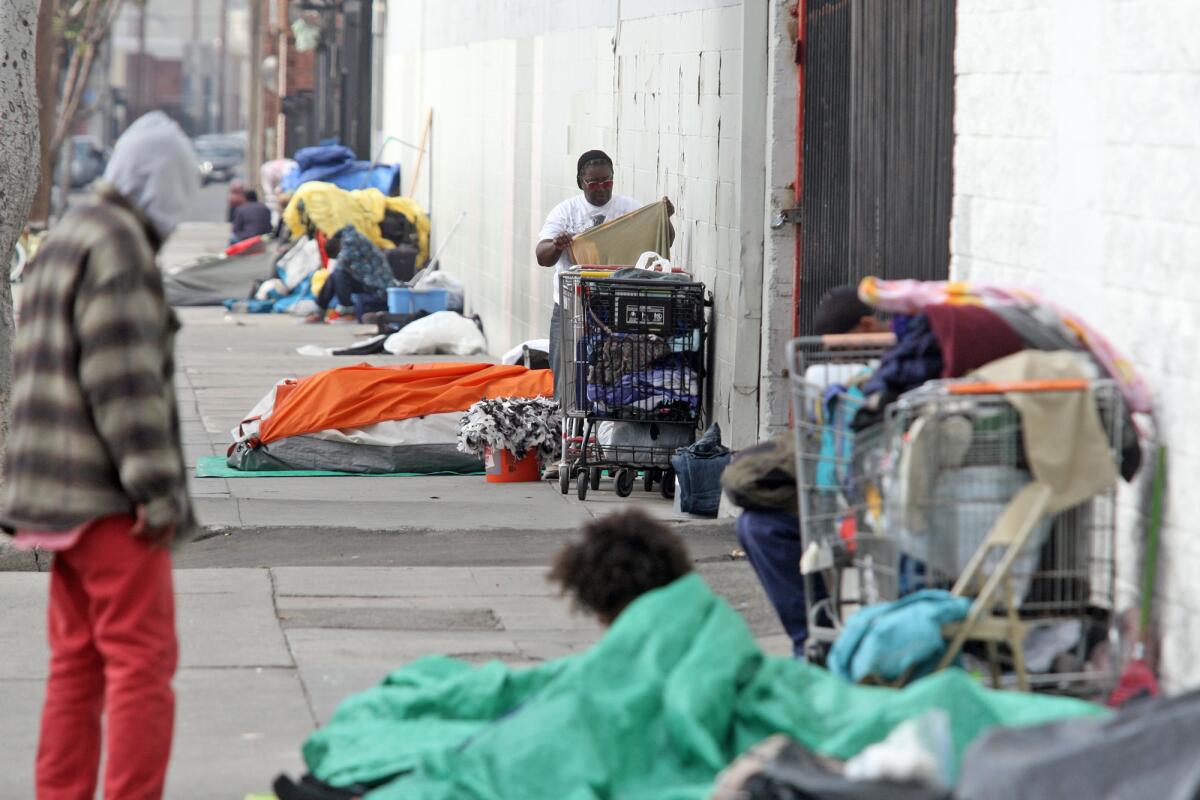L.A. to declare ‘state of emergency’ on homelessness, commit $100 million

Annie Moody adjusts belongings next to her tent on Towne Avenue at 6th Street in Los Angeles.
- Share via
Acknowledging their failure to stem a surge in homelessness, Los Angeles’ elected leaders on Tuesday said they would declare a “state of emergency” and devote up to $100 million to the problem. But they offered few details about where the money would come from or how it would be spent, leaving some to question the effort’s chances of success.
The announcement by seven City Council members and Mayor Eric Garcetti was a powerful signal of growing alarm at City Hall over L.A.’s homeless population, which has risen 12% since 2013, the year Garcetti took office. It coincided with a directive from the mayor Monday evening that the city free up an additional $13 million in the coming months to help house people living on the streets.
Some lawmakers assert that their proposed declaration — which the council must still vote to approve — would allow the city to ease restrictions on churches and nonprofit groups sheltering the homeless and speed up the permitting process for builders of affordable housing. They pointed to a state law that allows the city to declare a “shelter crisis” and use public facilities such as parks or schools as emergency housing.
RELATED: How L.A.’s homeless crisis got so bad
“It’s time to get real, because this is literally a matter of life and death,” said Councilman Mike Bonin, whose Westside district is home to many of the makeshift sidewalk encampments that are an increasingly glaring symbol of the problem across the city. He spoke of a “collective failure of every level of government to deal with what has been a homeless crisis for generations and is exploding and exacerbating now.”
Despite such tough talk, however, Tuesday’s announcement was marked by signs of the confused tactics critics say have hindered an effective city response to a growing challenge. Council members haven’t identified the sources for all of the money or how it would be used. Meanwhile, the mayor has yet to release a sweeping plan — now weeks overdue — he says he is crafting to end homelessness.
“This is all simply words,” said Mark Ryavec, president of the Venice Stakeholders Assn., which has argued for a more aggressive approach to clearing encampments and housing the homeless. “Again, it shows an ongoing lack of leadership on behalf of the city.”
See the most-read stories this hour >>
Gary Blasi, a professor emeritus at the UCLA School of Law, said the promise to fund new housing and services for the 26,000 homeless people in L.A. was a positive step for a city government that has recently been preoccupied with empowering the police to crack down on encampments.
“If it is purely symbolic, that will be bad,” Blasi said. “But at least people are engaging in a conversation about how to solve the problem instead of just moving it around the city.”
Tuesday’s announcement was the second high-profile declaration about homelessness from L.A. city officials in as many months. Late in July, Garcetti said in a speech that his office was preparing a three-part “battle plan” for what he dubbed a “war on homelessness here in Los Angeles.” He said the plan would be released in “about a month.”
Two months later, the mayor’s office has not issued the plan, although Garcetti has spoken in broad strokes about what it would involve.
On Tuesday he said its “main pillars” were the expansion of a system for tracking homeless people used by county and city officials; new centers for street dwellers to store their belongings and use social services; and anti-poverty measures (such as L.A.’s recent move to raise the minimum wage) that could prevent people from losing their homes in the first place.
The directive issued Monday night is intended to fund stopgap measures until Garcetti’s larger plan is finalized. The mayor asked City Administrative Officer Miguel Santana to find funding for initiatives such as housing subsidies for the newly homeless and to keep the city’s winter shelters open an extra two months through what is expected to be a season of heavy rain and floods.
“These are our fellow Angelenos,” Garcetti said Tuesday, referring to the people who regularly sleep on the lawns and benches around City Hall. He said they “have no other place to go, and they’re literally here where we work, a symbol of our city’s intense crisis.”
In an interview, Santana, the city’s top financial official, declined to say where the money sought by the mayor and council could be found in a budget that only recently began to recover from revenue shortfalls caused by years of recession.
The council is “asking us to look at all revenues the city has access to, so we will do that,” he said. Bonin, a member of the city’s budget committee, said much of the $100 million could come from the city’s reserve fund, which is set aside for financial emergencies.
Councilman Gil Cedillo, chairman of the city’s housing committee, said some of the money could be used to install lights and hire guards for city and church parking lots, which could host people living in their cars or RVs. He also suggested designating city-run pools as places for the homeless to shower and easing planning and environmental regulations to speed up construction of low-income housing projects.
“We need to act like it’s an emergency,” Cedillo said. “We can’t do business as usual.”
The homelessness problem’s reach can be seen in the clusters of tents, tarpaulins and shopping carts that have spread far beyond downtown’s skid row, taking root in neighborhoods from Studio City to Highland Park. The number of encampments and vehicles occupied by the homeless has increased 85% over the last two years, according to the Los Angeles Homeless Services Authority.
For merchants and homeowners, the encampments can be an unpleasant and sometimes dangerous disruption of daily life. Councilman Paul Krekorian, who represents part of the San Fernando Valley, said he receives calls “on a daily basis” from constituents concerned about the issue. An aide to Councilman Joe Buscaino said about 1,200 people attended a recent meeting in San Pedro on the problem.
Though other big U.S. cities have seen rising homelessness numbers, L.A.’s problem has gained special notoriety. In August, New York City Police Commissioner Bill Bratton — a former chief of the Los Angeles Police Department — said in a much-publicized radio interview that “L.A. has probably the worst situation in the country of homeless.”
Council President Herb Wesson said one goal of the emergency declaration was to give Garcetti leverage as he seeks additional funding for homelessness programs from the county, state and federal government — demonstrating L.A.’s seriousness about the issue by pledging a chunk of its own budget.
The declaration is also intended to show that the council, which in May approved a controversial ordinance enabling the police to sweep encampments from the sidewalks, is willing to devote resources to housing and services as well as street enforcement.
“The key for us is to try to come up with money to be spent taking people off the street, and that we really haven’t invested in,” Wesson said. “We’ve got to begin that conversation.”
Jay Handal, chairman of the West L.A.-Sawtelle Neighborhood Council, said the council is moving in the right direction but has its work cut out.
“It’s going to take a whole lot more than $100 million, spent wisely, to fix the problem we’ve created for 40 years,” Handal said. “But this is a good start.”
For breaking news in California, follow @MattHjourno.
ALSO:
All the ‘Happy Birthday’ song copyright claims are invalid, federal judge rules
California seeks to build one of world’s largest recycled water programs
New policy returns immigration agents to L.A. County jails
More to Read
Sign up for Essential California
The most important California stories and recommendations in your inbox every morning.
You may occasionally receive promotional content from the Los Angeles Times.













